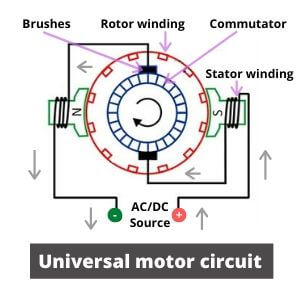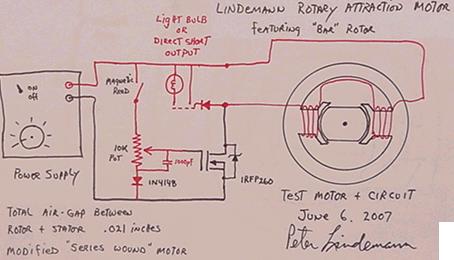Announcement
Collapse
No announcement yet.
Motor Generators
Collapse
X
-
IMG-20220519-WA0009.jpg IMG-20220519-WA0012 (1).jpg IMG-20220519-WA0011.jpg IMG-20220519-WA0010.jpg no, I don't convert an alternator into a motor, I just modified the motor to avoid it using a part of current to produce the magnetic field of the rotor, now I will try to post the photos.this is the rotor I modifiedAttached Files
Comment
-
IMG-20220519-WA0005.jpg this is the machine, of course being a test I didn't waste too much time to look after the appearance and I used recycled materials, so don't pay attention if the structure seems a bit strange, the important thing is that it absolves me well task. Now I would need a scheme for powering the engine at short adjustable periods to find the best combination to give the flywheel enough momentum and keep the batteries charged. IMG-20220519-WA0006.jpg
Comment
-
Thanks Memphis
I am straight up now. You have a motor where the rotor has a winding on it normally but you eliminated the brushes and the winding which creates a magnetic field was replaced with magnets. Your motor is called a "UNIVERSAL MOTOR"
You have a motor where the rotor has a winding on it normally but you eliminated the brushes and the winding which creates a magnetic field was replaced with magnets. Your motor is called a "UNIVERSAL MOTOR"
This is not an easy task, look at a treadmill circuit board / controller they are using a universal motor or a PMM. You can power a universal motor with AC or DC. They are the same as a drill motor which can run on either. I am unsure what the inspection plate says on your motor.
You are somewhere in between but now a PMM, try 48vdc and work your way up with a Variac is a good first step. Because you took out half the windings.
Ask David Bowling, he is powering a universal motor up and changing the RPM's
He could tell you where to buy one. How about it Dave, got any inklings?
.................Last edited by BroMikey; 05-20-2022, 03:43 AM.
Comment
-
Also Memphis
You will be interested to know that Peter Lindemann gutted a universal motor rotor but he did not use magnets, he use a solid rotor and he got good results. Without magnet just a piece of iron for the rotor he got good power and more RPM's than when the motor was made using only 20vdc pulsed. This is because the universal has 2 windings and they are the rotor winding plus the outside winding in series. I repeat both windings are in series running on 115vac or 115vdc. BUT when you remove half the windings you will not be able to run the outer winding on 115v because of the amp draw. You must find the right voltage for your converted motor by slowly increasing the volts while measuring the amps in your winding being careful not to exceed the awg wire rating. You can look at the motor plate and see the rated amps. When the amps are reached that will be your max voltage.
This is a general dia of a universal motor but the rotor winding are not shown.
 Last edited by BroMikey; 05-20-2022, 04:02 AM.
Last edited by BroMikey; 05-20-2022, 04:02 AM.
Comment
-
This universal motor dia is better because it shows all of the windings and how they are connected. When you chop off half the windings the resistance is less and 115v will melt the remaining winding. I want to do this myself and have been thinking about it.
Come to think about it start at 20v and go higher till the amp draw rating peaks.
You will need more than a pulse circuit you will also need the circuit to use a hall effects sensor to time the pulses. Normally the timing is done by way of the commutator.
 Last edited by BroMikey; 05-20-2022, 04:21 AM.
Last edited by BroMikey; 05-20-2022, 04:21 AM.
Comment
-
Memphis
This is what you are doing except the outside winding in your case is not 3 phase so you can't use the RC out of the box ESC controllers that have built in timing.
Look on your motor plate for RPM, if it is 3600 the motor is two pole or 2 phase. You are creating a BRUSHLESS DC motor and your rotor windings are just like an alternator rotor.
Do you know if the motor plate says 1ph or single phase? Or is your motor a 3 phase motor?
Last edited by BroMikey; 05-20-2022, 04:57 AM.
Comment
-
-
Here is one with magnets modified rotor and controller same as your 3 phase motor same as a 3 phase alternator with the rectifier removed. Everybody is doing this, this is nothing new. It works well from what I hear. You do not have a universal motor, you had a 3 phase motor that you have converted to a 3 phase DC brushless PMM ( PMM = permanent magnet motor) this is a winner.
If your motor is 220v you might be in trouble finding a controller for high voltage. I have seen up to 90vdc.
Notation: disregard all entries about universal motor controllers.
Last edited by BroMikey; 05-20-2022, 05:55 AM.
Comment
-
Mikey what you see disassembled is the three-phase 24v alternator of a bulldozer to which I replaced the rotor winding with magnets (so I also eliminated the brushes and the control circuit, now the output varies according to the speed of rotation, at 2500 rpm it takes out 42V.) The motor is the black one you see mounted in the photos on the right, it is a 24V, 500watt direct current.Now I need to power that pulse engine.Thanks always for the help.
Comment
-
Hi Memphis
Looks like it is a 24vdc golf cart motor so it is like a universal motor some call "series wound" especially since you had to remove brushes and add magnets so everything I said about universal motors apply. By removing the commutator action with it's windings in series with the outside windings you have eliminated the timing for which the motor coils fire. Therefore you will need a circuit that fires pulses based on a sensor you will need to place on the shaft.
Did you see my earlier post of Peter Lindemann's simple / effective circuit for a universal motor? His little circuit does the pulsing using a magnetic reed switch plus recovers all of the collapsing field energy back to an extra battery. You could use a hall effects switch also.
Here it is and how when taking out the rotor you hook the 2 outside windings
 Last edited by BroMikey; 05-20-2022, 05:16 PM.
Last edited by BroMikey; 05-20-2022, 05:16 PM.
Comment
-
Comment
-
but my problem is not the alternator that works very well, but I just need a circuit that sends me the current to the 24v brushless direct current motor that pulses the flywheel, therefore an adjustable pulse current, not a regulator speed which in this case would act on the supply voltage (being a DC motor).
Comment




Comment